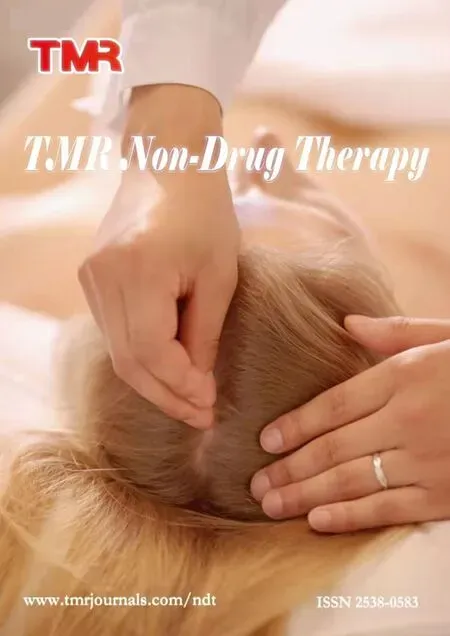Research status of peri-menopausal insomnia based on bibliometrics
Lin-Hui Li,Yi-Hua Fan ,Mei-Ying Zhu,Yuan Qin,Yi-Xuan Dong,Chun-Yan Zhang*
1Tianjin University of Traditional Chinese Medicine,Tianjin 301617,China.2First Teaching Hospital of Tianjin University of Traditional Chinese Medicine,Tianjin 300193,China.3National Clinical Research Center for Chinese Medicine Acupuncture and Moxibustion,Tianjin 300381,China.
Abstract Objective:To reflect the current situation and development level of the treatment of peri-menopausal insomnia,to provide ideas and basis for the treatment of peri-menopausal insomnia,and to lay a scientific foundation.Methods:The relevant literatures about peri-menopausal insomnia in the past 20 years from January 1,2000 to September 30,2020 were searched in full-text database,and the publication time distribution,periodical distribution and research types were statistically analyzed with the help of NoteExpress 4.2.0,Excel 2010 and UCINET 6.2 software.Bibliometrics and social network analysis were used to grasp the research status and research hotspots.Results:979 articles about insomnia in peri-menopausal period were included.The number of literatures showed an upward trend and decreased from 2018 to 2020.The top three journals are Inner Mongolia traditional Chinese Medicine,Guangming traditional Chinese Medicine and Sichuan traditional Chinese Medicine,with 30,25 and 22 articles respectively.A total of 1,846 authors participated in the publication.The top three authors were Hong Li(14,0.63%),Jun-Shan Huang(9,0.40%)and Ying Chen(9,0.40%).The social network map shows that“insomnia”,“peri-menopausal period”,“perimenopausal insomnia”,“peri-menopausal syndrome”,“traditional Chinese medicine therapy”and“acupuncture”are the research hotspots and have the strongest correlation.Conclusion:The number of articles about peri-menopausal insomnia shows a downward trend in recent years,and the“core author group”has not been formed.The clinical research in this field is relatively perfect,but a more complete theoretical system has not been formed yet.Most of the treatment of insomnia in peri-menopausal period is based on traditional Chinese medicine,which shows that traditional Chinese medicine is more effective in clinical use,and the curative effect of syndrome differentiation of traditional Chinese medicine has been affirmed.However,there are relative deficiencies,such as the lack of strict experimental research and evaluation standards,the lack of unilateral prescription research,and so on.Future researchers should pay more attention to the experimental research of traditional Chinese medicine in the treatment of peri-menopausal insomnia and unilateral empirical prescription research.
Keywords:Peri-menopausal insomnia,Bibliometrics,Social network analysis
Background
Insomnia is a kind of common clinical disease characterized by frequent failure to get normal sleep.Its symptoms are as follows:prolonged sleep latency:falling asleep for more than 30 minutes;sleep maintenance disorder:sleep awakening times≥2 or waking up early in the morning;decline in sleep quality:shallow and dreamy sleep;shortening of total sleep time:usually<6 hours;residual effects:dizziness,lethargy,lethargy and so on in the next morning.The above sleep disorders were maintained at least 3 times a week and lasted for more than 1 month[1].It belongs to the categories of“insomnia”,“no sleeping”,“sleepless”and“nability to sleep”in traditional Chinese medicine.Insomnia is one of the main symptoms of peri-menopausal syndrome.The national health survey found that the frequency of symptoms of menopausal women is as high as 75.2%,and the incidence of insomnia is in the forefront[2].It has caused great harm to the physical and mental health of peri-menopausal women.Peri-menopausal insomnia can aggravate other physical symptoms of peri-menopausal period and increase the probability of breast and uterine lesions in women.Long-term insomnia seriously reduces the quality of life of peri-menopausal women and affects their physical and mental health,so it has been widely valued by clinical and medical researchers.However,there is still a lack of research on the current situation of peri-menstrual insomnia,so this paper uses the method of bibliometrics to make a statistical analysis of the academic papers on peri-menstrual insomnia in the past 20 years in order to objectively describe the research status of peri-menstrual insomnia.
This paper uses NoteExpress 4.2.0 to search the three major Chinese databases of China National Knowledge Infrastructure,Wanfang and VIP,and selects and includes qualified literature by using the methods of bibliometrics and social network analysis,this paper analyzes the current research situation of peri-menopausal insomnia,and quantitatively analyzes the research hotspots on the basis of key words,so as to provide a reference basis for clinical research on peri-menopausal insomnia and improving the current situation of peri-menopausal women’s insomnia.
Methods
Data sources
The literature sources of this study are published in the databases of China National Knowledge Infrastructure,VIP and Wanfang data.
Search strategy
The subject retrieval of the three major databases is based on advanced retrieval,and the time is limited to“January 1,2000 to September 30,2020”.The search method is(the subject word“insomnia”or contains“insomnia”)and contains(the keyword“menopause”or“peri-menopausal period”).
Inclusion and exclusion criteria
Inclusion criteria.(1)The clinical research literature on the treatment of peri-menstrual insomnia with traditional Chinese medicine,western medicine or integrated traditional Chinese and western medicine.(2)The literature about the theory,review,nursing,famous doctor experience and personal clinical experience of traditional Chinese medicine,western medicine or combination of traditional Chinese and western medicine in the treatment of peri-menstrual insomnia.
Exclusion criteria.(1)Animal experimental research,investigation and popular science literature on peri-menstrual insomnia.(2)Repetitive,non-Chinese literature.
Results
1,034 articles were found in China National Knowledge Infrastructure database,3,802 in Wanfang database and 94 in VIP database.A total of 979 articles were obtained after checking the literatures obtained in the first examination and excluding the repetitive ones which did not meet the inclusion criteria.The literature screening process and results are shown in Figure 1.
Basic features of literature
Annual distribution of literature.The chronological distribution of peri-menopausal insomnia is shown in Figure 2.A total of 979 papers on peri-menopausal insomnia were published from January 1,2000 to September 30,2020.The number of papers increased during 2000–2018,decreased slightly in 2008 and 2015,and reached the most exciting part in 2018.A total of 132 papers(accounting for 13.48% of the total papers)were published in 2018,and the number of papers published showed a downward trend in the next two years.It can be seen from Figure 2 that the period from 2015 to 2019 is a hot period for the study of peri-menopausal insomnia,accounting for 53.42% of the total papers,with a total of 523 papers published.
Type of published literature.As of September 30,2020,among the 979 articles on insomnia in related and peri-menopausal periods,journal papers were the most,with a total of 833,accounting for 85.96%,followed by degree papers,90,accounting for 9.19%,and 56 conference papers,accounting for 5.72%(Figure 3).

Figure 1 Literature screening process and results
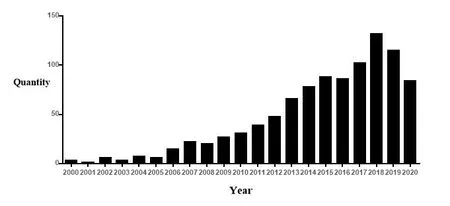
Figure 2 Annual distribution of literature
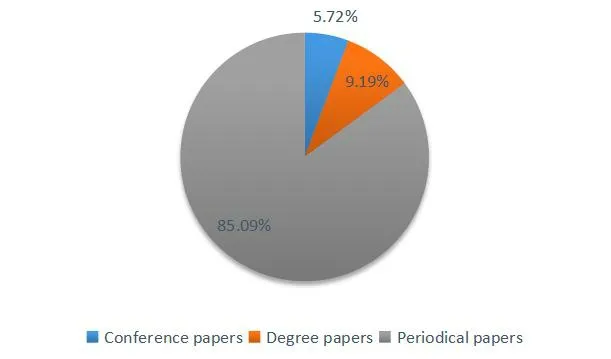
Figure 3 Type of published literature
Source journal distribution.Periodical distribution of literature:833 related articles were published in 250 journals.Among them,the number of articles in 20 journals reached 9 or more,with a total of 267 articles,accounting for 27.27% of the total literature.Inner Mongolia traditional Chinese Medicine has the largest number of articles,with 30 articles.The number of articles published in journals with more than 9 articles(including 9 articles),journal impact factors(2019)and whether they are Chinese core journals are shown in Table 1.

Table 1 Source journal distribution
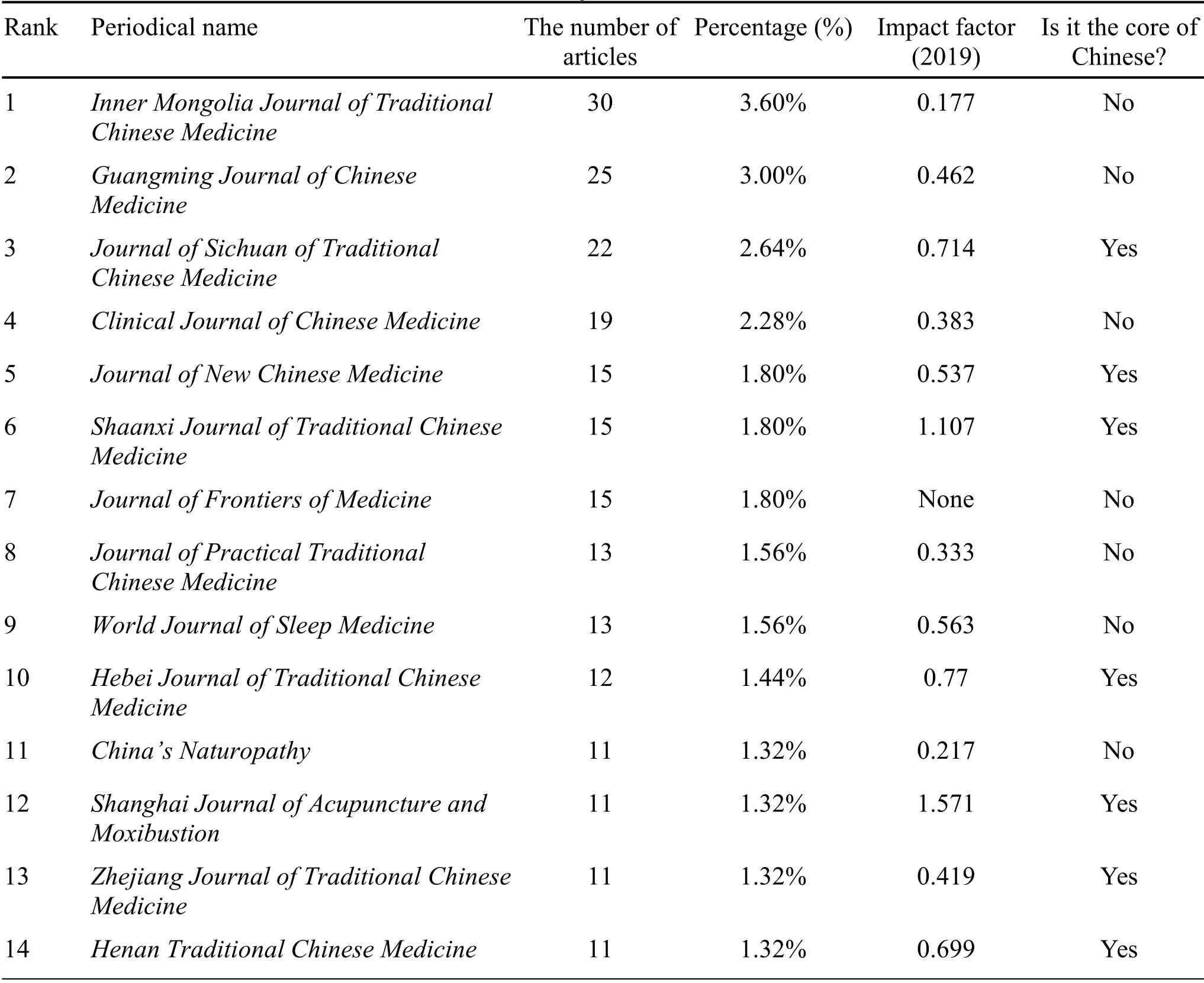
Table 1 Source journal distribution
Core author.A total of 1846 authors participated in the publication of 979 articles included in this study.Among them,the author with the largest number of articles is Hong Li from Fujian Medical University,who has published a total of 14 articles.According to Price’s Law[3],the value of the minimum number of posts for core authors is m=0.749nmax is the most productive number of posts by authors.The number of posts of the most productive authors is 14,and it is calculated that the number of posts is 2.80,rounded to 3,and the authors with more than 3 posts can be used as candidates for core authors.A total of 62 authors published more than 3 articles(including 3 articles),accounting for 3.36% of the total authors.These authors published a total of 259 articles,accounting for 26.46%<50% of the total literature,which did not meet the requirements of Price’s law.That is,the study of insomnia in peri-menopausal period has not formed a“core author group”.The authors of the top ten posts are shown in Table 2.
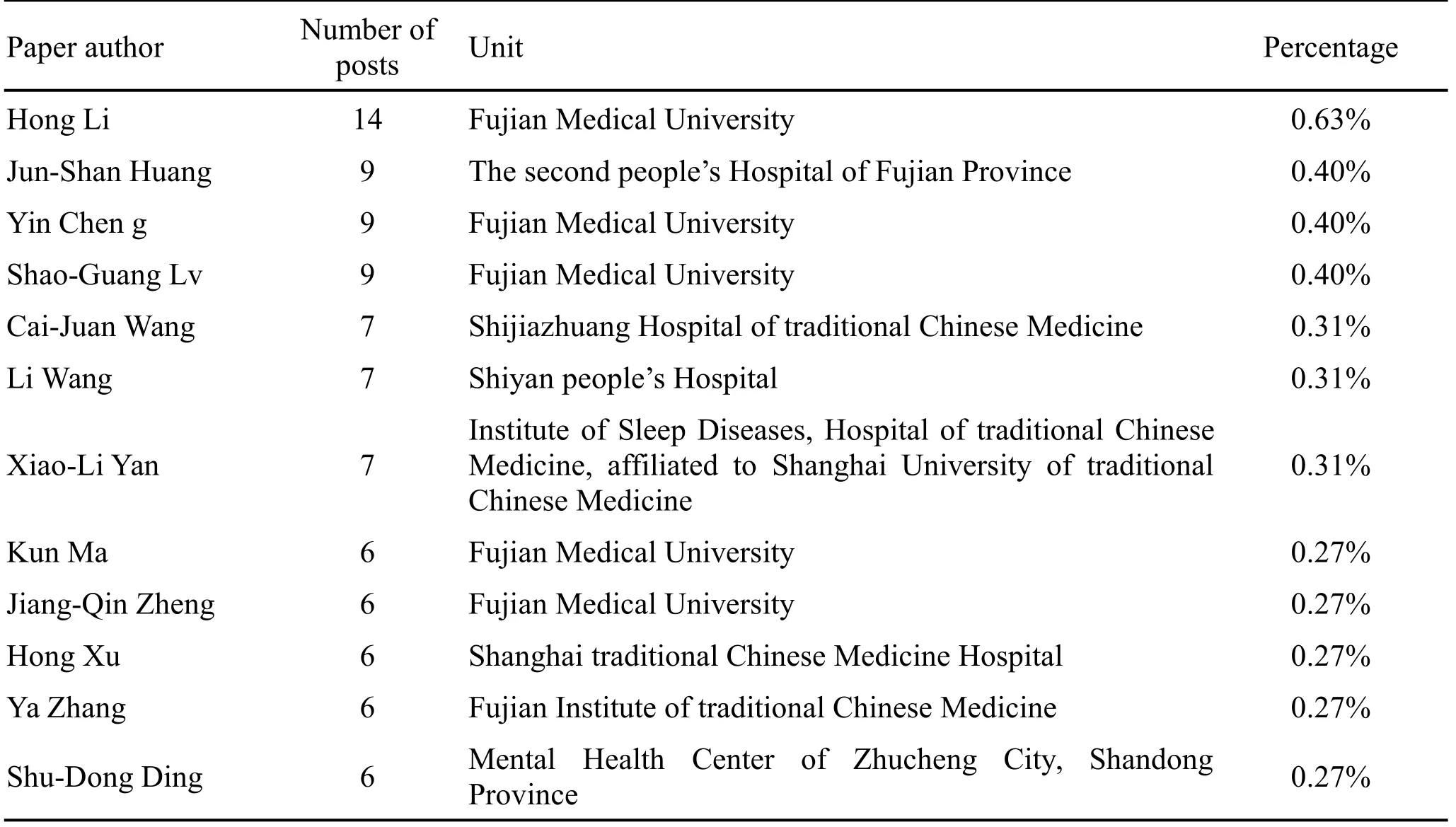
Table 2 The author of the top ten posts
Study type distribution of literature.The research types of 979 related literatures are mainly related to six categories:clinical research,review,theory,famous doctor experience,nursing and individual case.Among them,the clinical research literature is the most,with 766 articles,accounting for 78.24% of the total literature.The distribution of research types is shown in Table 3.
Treatment methods in clinical research literature.Among the 766 clinical research literatures,the treatment methods used were traditional Chinese medicine therapy,integrated traditional Chinese and western medicine therapy,acupuncture and massage therapy,external treatment and western medicine therapy,and two or more of them were classified as comprehensive therapy.Those without detailed description of therapy are classified as others.The use of clinical research literature treatment methods is detailed in Table 4.
Research methods of clinical research literature.Among the 766 clinical research literatures,there are three kinds of research methods:clinical trial,observational study and clinical experience summary.Among them,observational research has the largest number of literatures,with 405 articles,accounting for 52.87% of the total clinical research literature.The use of literature research methods in clinical research is detailed in Table 5.
Construction of social network map for health investigation and research of traditional Chinese medicine.(1)High frequency keyword analysis:the top 5 keywords of occurrence frequency are insomnia,peri-menopausal period,peri-menopausal insomnia,peri-menopausal syndrome and traditional Chinese medicine therapy,as shown in Table 6.(2)Constructing high frequency keyword co-word matrix:determine the number of high-frequency keywords in the study of peri-menopausal insomnia as the first 24,generate a co-word matrix(Table 7),and provide data support for the construction of high-frequency keyword co-occurrence network knowledge graph,and lay the foundation for follow-up analysis.(3)Construct social network graph of high frequency keywords:based on the social network analysis of 24 key words,“insomnia”, “peri-menopausal period”,“peri-menopausal insomnia”, “peri-menopausal syndrome”,“traditional Chinese medicine therapy”and“acupuncture”are at the center of the network.together with other keywords in the same literature for the most times,is an important node in the network,in the core position,that is,other research fields are carried out around this core(Figure 4).
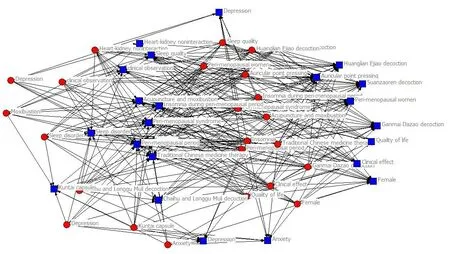
Figure 4 social network graph of high frequency keywords

Table 3 Study type distribution of literature
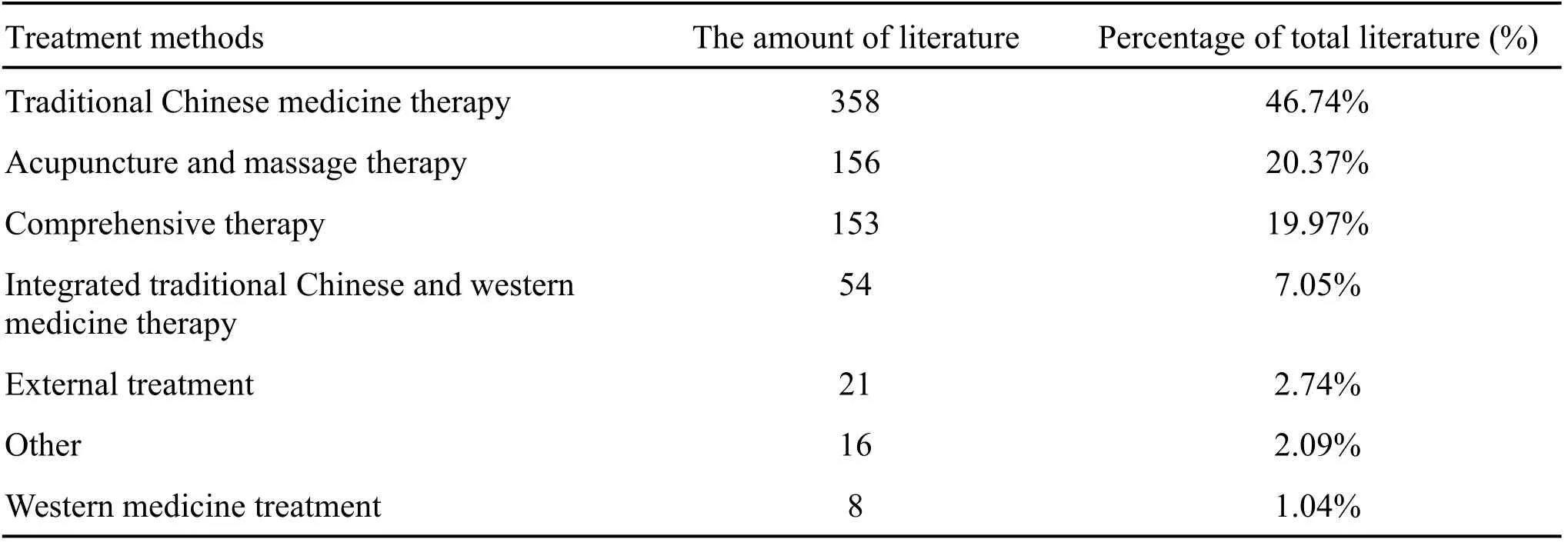
Table 4 Treatment methods in clinical research literature

Table 5 Research methods of clinical research literature

Table 6 High frequency keyword analysis
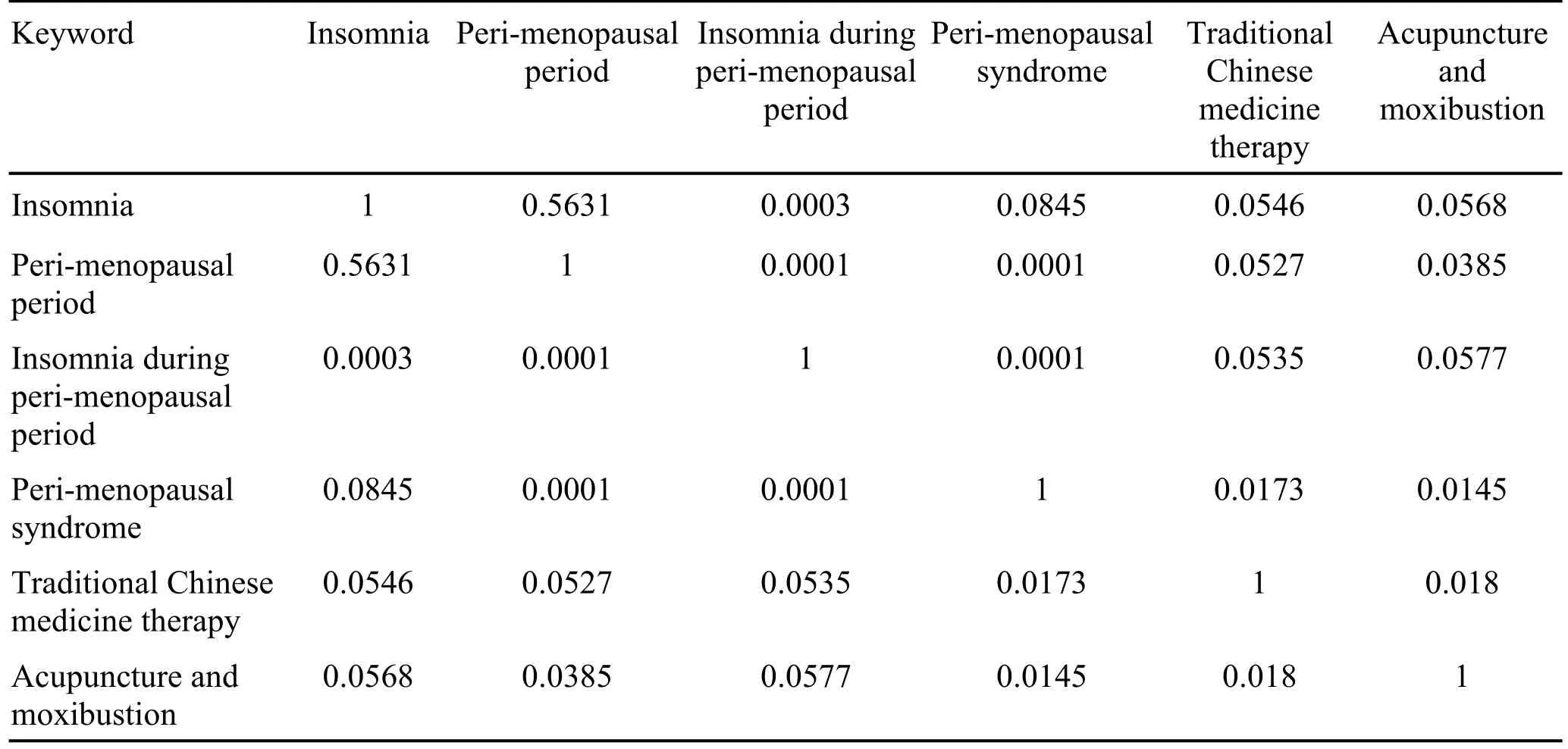
Table 7 High frequency keyword co-word matrix(part)
Discussion
Insomnia will have many adverse effects on the human body,patients often have mental fatigue,dizziness,headache,tinnitus,palpitation,shortness of breath,memory loss,often feel anxiety and fear,emotional impulse[4],all these can affect family harmony,make interpersonal relations tense,and cause great mental and physical pain to patients.For peri-menopausal women,insomnia will also increase the probability of breast,uterine and other lesions.Therefore,it is urgent and necessary to make an in-depth study of insomnia in peri-menopausal women.In the past two decades,insomnia has attracted wide attention of researchers.In clinical research,theoretical research,famous medical experience and other aspects of the literature also showed a growing trend.
In this paper,based on the statistical analysis of the literature on insomnia in peri-menopausal period in the past two decades,the following conclusions are drawn:from the chronological distribution of the published literature in Figure 2,the published literature showed an overall upward trend from 2000 to 2020,and the hot period from 2015 to 2019 was the hot period for the study of insomnia during peri-menopausal period,accounting for 53.42% of the total papers,with a total of 523 papers published.It can be seen from Table 1 that 833 related articles are published in 250 journals.Among them,the number of articles in 20 journals reached 9 or more,with a total of 267 articles,accounting for 27.27% of the total literature.Inner Mongolia traditional Chinese Medicinehas the largest number of articles,with 30 articles.It can be seen that these 20 journals have become the main journals published by researchers on peri-menopausal insomnia.Among the 20 journals,there are 8 Chinese core periodicals,namely,“Sichuan Traditional Chinese Medicine”,“New Traditional Chinese Medicine”,“Shaanxi Traditional Chinese Medicine”,“Hebei Traditional Chinese Medicine”,“Shanghai Journal of Acupuncture and Moxibustion”,“Zhejiang Journal of Traditional Chinese Medicine”,“Henan Traditional Chinese Medicine”and“Guangxi Traditional Chinese Medicine”.There are two core journals of Chinese science and technology,which areLishizhen Medicine and Materia Medica ResearchandChinese Journal of Traditional Chinese Medicine.A total of 126 articles were published in these 10 core journals,accounting for 15.13%of the total literature.It can be seen that the proportion of literature published in the core journals with high influence is not high,indicating that there is still a lack of research in this field.Therefore,from the point of view of the distribution of source journals,the degree of dispersion is higher,the degree of concentration is lower,and the distribution of core journals is less,which reflects that the influence of the article is small,and the overall quality of literature needs to be further improved.According to Price’s law,the“core author group”has not yet been formed,but Hong Li,Jun-Shan Huang,Ying Chen and other authors have published the most articles and are the main scholars in the study of insomnia in peri-menopausal period.
It can be seen from Table 3 that the main type of literature research on peri-menopausal insomnia is clinical research,with a total of 766 related articles,accounting for 78.24% of the total literature.However,there are 60 reviews,56 experiences of famous doctors and 54 theoretical studies,indicating that the research in this field is still in the stage of development.Although the clinical research is more perfect,the experience summary of famous doctors is still less.A more complete theoretical system has not been formed yet.As can be seen from Table 4,among the commonly used clinical treatment methods,traditional Chinese medicine is the most commonly used treatment,accounting for 46.74%.It shows that the therapy of traditional Chinese medicine is more effective in clinical use,and the curative effect of syndrome differentiation of traditional Chinese medicine is affirmed.Secondly,acupuncture and massage therapy also has a good effect,accounting for 20.37%.In contrast,the use of western medicine is less,accounting for only 1.04% of the total clinical research literature.It shows that western medicine is rarely used in clinic,and further research is needed for the use of western medicine.In addition,the clinical treatment also used the combination of traditional Chinese and western medicine therapy,comprehensive therapy and external treatment.It shows that there are various effects in the treatment of peri-menopausal insomnia.
Combined with the analysis of high-frequency keywords(Table 6),there are many studies on the treatment of peri-menopausal insomnia with traditional Chinese medicine,and the frequency of insomnia of heart-kidney disharmony type is higher.In the clinical treatment of traditional Chinese medicine,Bupleurum plus dragon bone Oyster soup,Huanglian Ejiao decoction,Suanzaoren decoction and Ganmai Dazao decoction are used as the base prescription for the treatment of peri-menopausal insomnia,and Kuntai capsule,a proprietary Chinese medicine,is mainly used to treat peri-menopausal insomnia.It shows that the application of these prescriptions has achieved good clinical results[5].At the same time,these prescriptions have the effect of nourishing the heart and calming the mind and communicating the heart and kidney,indicating that the deficiency syndrome of insomnia in peri-menopausal period is mostly.In addition to traditional Chinese medicine therapy,external treatment methods such as acupuncture,auricular point pressing and moxibustion are also used in the treatment of peri-menopausal insomnia.It is simple,economical,safe and easy to popularize to community hospitals and families,so it is widely used in the treatment of this disease[6].It can be seen from the picture that some patients with peri-menopausal insomnia are accompanied by psychological changes such as anxiety or depression.The study found that women with peri-menopausal syndrome generally have bad emotions such as anxiety and depression[7].It is suggested that in the process of treating peri-menopausal insomnia,we should also pay attention to the psychological status of peri-menopausal insomnia women,and do a good job in timely guidance and treatment[8].
In order to show the node centrality more intuitively and clearly,the high-frequency keyword co-word matrixis visually analyzed by UCINET6.2 software(Table 7),and the social network diagram of high-frequency keywords is drawn(Figure 4).In the network diagram,the size and location of keyword nodes represent the focus and core of research in this field.Generally speaking,the larger the keyword node is,the more central it is,and the more hot and core the research is[9].As can be seen from Figure 4,“insomnia”, “peri-menopausal period”,“perimenopausal insomnia”, “peri-menopausal syndrome”,“traditional Chinese medicine therapy”and“acupuncture”are at the center of the network map,which are the research hotspots in this field.
To sum up,the number of literature on peri-menopausal insomnia is increasing,and the research topic is mainly focused on clinical research,the summary of clinical experience is not enough,and it is still in development.The treatment of peri-menopausal period is mainly treated by traditional Chinese medicine[10],which has a broad application prospect,but it also has relative shortcomings,such as the lack of strict experimental research and evaluation standards,insufficient research on unilateral empirical prescription,and so on.in the future,researchers should pay more attention to the experimental research and unilateral empirical prescription of traditional Chinese medicine in the treatment of peri-menopausal insomnia.
- TMR Non-Drug Therapy的其它文章
- Research progress on non-drug treatment of diabetic kidney disease
- Acupuncture of different stimulation for the treatment of neck type cervical spondylosis:a randomised controlled trial
- Application progress of acupuncture in treatment of ovarian hypofunction
- Care for a patient with hip trauma caused by a car accident:a case study
- Nursing care of a patient with acute mastitis after dystocia

